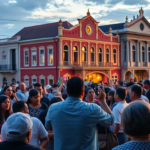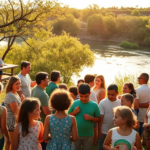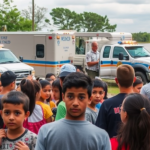Starr County Meteorites Illuminate the Rio Grande Valley at MOST History Exhibit
The Museum of South Texas History (MOST History) in Edinburg is currently home to an extraordinary exhibit that brings the cosmos closer to the community: meteorites from Starr County. This remarkable showcase delves into the celestial phenomena that first captivated humans centuries ago and continues to intrigue Valley residents today. Highlighting the significance of these interstellar visitors, the exhibit promises to invigorate interest in science and local history, while fostering a sense of wonder and curiosity across the Rio Grande Valley.
A Celestial Journey to Edinburg
The exhibit explores the fascinating journey of meteorites, from their fiery descent through Earth’s atmosphere to their final resting places on its surface. The pieces on display were discovered in Starr County, offering a local facet to the cosmic story. These meteorites, each with unique characteristics and compositions, provide a tangible link between the stars and South Texas, emphasizing the importance of local geological history.
Steve Garcia, a curator at MOST History, expressed excitement about the exhibit’s potential impact: “Meteorites are windows into the past, offering clues about the origins of our solar system. By showcasing these celestial objects found right here in Starr County, we hope to ignite a passion for science and history among the community.”
Local Impact and Community Interest
For the Rio Grande Valley, the exhibit represents more than an exploration of space. It’s an opportunity to engage Valley residents in meaningful dialogues about the interplay between science and local heritage. The meteorites serve as a reminder of the region’s geological uniqueness and its place in the broader scientific narrative, sparking curiosity and inspiring future educational initiatives.
Amelia Rodriguez, a local teacher who visited the exhibit with her students, shared her perspective: “Learning about these meteorites helps our students see the universe in a new light. It ties our small community to the vast cosmos and shows that science isn’t just something done in distant labs—it’s happening right here.”
Bridging Past and Present: A Historical Context
The meteorites on display offer a new dimension to the existing historical narratives of the Rio Grande Valley. The region, known for its rich cultural and historical tapestry, now adds cosmic phenomena to its legacy. Historical records suggest that meteorite falls have long fascinated and sometimes mystified local communities, with many cultures attributing significant meaning to these “stones from the heavens.”
MOST History has designed the exhibit to weave these historical threads with scientific understanding, providing a comprehensive view that discusses both past interpretations and modern scientific insights.
Future Implications for the Community
The presence of the meteorites at MOST History could have lasting implications for science education in the RGV. By fostering an environment where science is accessible and engaging, the exhibit supports ongoing efforts to enhance STEM (Science, Technology, Engineering, and Mathematics) education in the area, encouraging students to pursue careers in these vital fields.
Laura Mendoza, a STEM advocate and community leader, emphasized the importance of such exhibits: “Exhibits like these can inspire the next generation of scientists and researchers from our community. The more we can bring science to life through local relevance, the more we can motivate young minds to explore these paths.”
Encouraging Dialogue: Different Perspectives
While the exhibit has been met with enthusiasm, it also opens the floor to broader conversations about public engagement in science and history. Some community members see it as a chance to further integrate educational resources with local culture, advocating for more collaborative efforts between museums, schools, and local organizations.
Conversely, questions arise about how to maintain and sustain interest in such exhibits beyond their initial launch. Gabriela Santos, a museum volunteer, mentioned, “It’s important that we continue to innovate and find creative ways to keep the public engaged. Through workshops, interactive sessions, and digital content, we can extend the life and reach of exhibits.”
Connecting the Community: Resources and Engagement Opportunities
MOST History encourages Valley residents and visitors to engage with the exhibit through a variety of programs, including guided tours, lectures by geologists and astronomers, and hands-on educational activities for younger audiences. These initiatives aim to deepen understanding and appreciation of the exhibit, encouraging ongoing dialogue and learning.
For those interested in connecting further, the museum offers memberships that include access to exclusive events and forums where local stories are celebrated alongside global scientific discoveries.
In summary, the Starr County meteorites on display at MOST History are more than just relics from space—they are catalysts for community engagement, education, and inspiration. As the Rio Grande Valley continues to embrace its role in the intricate tapestry of both human history and cosmic science, exhibits like these pave the way for countless dialogues and discoveries, energizing a community that constantly looks to the stars while firmly rooted in its rich South Texas heritage.







